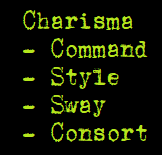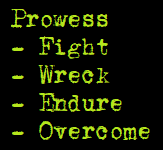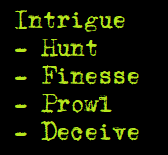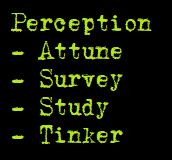The Game of Silent Weapons (Long Version)
Having now given a rough overview of the game, I feel like I can now spend the time to go into deeper detail concerning the gameplay, at both the global and local scales.
First, though, I want to revisit the question of what genre the game belongs to.
A Role-Playing Strategy Game
It's a genre that only barely exists; whenever it springs up, it's not from previous games influencing later ones; except in the case of very direct, one-to-one inspiration like the army (no pun intended) of Jagged Alliance 2 imitators. Instead, like crustaceans evolving into crabs, the genre is independently re-invented over and over again, from generations of game developers all coming to the same revelation: that combining RPG and strategy game elements is extremely compelling. To be clear, I'm not talking about tactics game elements, I mean capital-S strategy game systems.
Most examples of the "genre" are created by inserting strategy into an RPG: King's Bounty, Jagged Alliance, Mount and Blade, and the cottage industries of imitators those three games inspired. But possibly the most famous example of the genre, and the one which is the biggest influence on Silent Weapons for Quiet Wars, got there from the other direction, starting from a strategy game and using RPG elements to "zoom in" to the world of the game: Crusader Kings II.
If you want a one-sentence elevator pitch for Silent Weapons, it's "Jagged Alliance 2 is going on inside of a The X-Files mod for Crusader Kings". That obscures a lot of detail, specifically that I'm not aiming for nearly the tactical detail of Jagged Alliance 2. I am very deliberately aiming for a simplified system that allows for tactical missions to be resolved much quicker than in proper tactics games, and this is to deal with what Sid Meier identified as the main problem of Covert Action; a game which is also quite comparable to Silent Weapons. Covert Action had a global strategy layer as well as tactical missions, and Sid observed that the missions went on so long that you forgot what you were doing back in the strategy layer.
In pursuit of RPG mechanics which reduce detail, while still hoping to preserve the good parts of tactical missions, I made a fairly drastic decision.
The First Forged in the Dark Video Game
Silent Weapons for Quiet Wars will be the very first video game ever to adapt the popular Forged in the Dark TTRPG ruleset made famous by its parent game, Blades in the Dark.
[LEGAL DISCLAIMER: I am in no way affiliated with the creators of Blades in the Dark. The Forged in the Dark, or FitD, ruleset is released under a creative commons attribution license. For more information, see here: https://bladesinthedark.com/licensing ]
If you're familiar with Blades in the Dark you're probably raising an eyebrow right now. FitD is not a system built on mechanics, it exists as a conversation between the players and the game master, and that conversation obviously can't happen when the game master is a computer. However...
I'm not going to get too deep into the weeds here, if only because playtesting will likely lead to significant changes, but I'm very confident that I can translate FitD into a video game system. I can give a quick summation, though, of what an interaction might look like.
AN EXAMPLE OF CHARACTER GAMEPLAY
The characters in the game have two means of interacting with the world: by being placed into Offices within Organizations, or being assigned as Agents to Plots. We'll be detailing an example of a plot here.
As I described in the short version of this post, Plots are analogous to Schemes in Crusader Kings, complete with random events which can occur while one is active. However, unlike Crusader Kings events, which typically present a tiny handful of options to choose from, Plot Developments (my fancy terminology for a random event happening during a plot) will offer a specific obstacle, challenge, or opportunity, which the crew will then engage with using the Forged in the Dark ruleset.
When presented with an obstacle, characters act by using their Knacks (in FitD these are called Action Ratings but I felt that Action was too generic of a word to use here. Skills is a word I'm already using elsewhere). Knacks are the basic verbs of character interaction (in the sense that these are actions that a character has a knack for), and they're organized under 4 attributes, as follows:
 |  |
 |  |
As an example, your crew may be working a plot to gain intelligence (and potentially blackmail) on a target character. In a Plot Development, one of your agents encounters resistance while conducting a stakeout operation: local police stumble onto a surveillance van which two of your agents are using.
Either of those agents could attempt to use any valid Knack to resolve the situation.
You'll probably want to pursue a smooth resolution, using charisma or intrigue:
- Use Command to convince the police that you have the superior jurisdiction and that they should leave you to your work.
- Use Consort if the character is plausibly a cop, and convince them it's totally fine that you're doing what you're doing.
- Use Prowl to evade the police - if you fail, this might trigger a car chase!
- Use Deceive to convince the police that you are cops and you have a warrant.
But violence is, naturally, an option.
- Use Fight to engage the police in outright combat - probably triggering a combat encounter unless you get a critical success on the roll.
- Use Wreck to try to ram the cops with your van - likely triggering combat or a car chase, and certainly blowing your cover!
Those six are the most appropriate knacks to attempt a direct resolution, but remember, you've got two agents, so two actions, and one could use a different knack to help set the other up for better success.
- Use Finesse to conceal the surveillance equipment, making outright deception easier.
- Use Survey to assess escape routes, making evasion more likely to succeed.
You could also send other agents who aren't immediately on the scene to try to assist, but delaying will reduce your Positioning (a Forged in the Dark system which makes it harder to achieve a good outcome).
And all of those are just the good options. It could very well be that neither of the agents in that van are any good at talking their way out of trouble, or shooting their way out either (after all, their job was to take photos and listen to phone calls, their knacks are probably Perception-based.) You can also attempt to use less appropriate knacks - and as an absolute last resort, to accommodate the lack of a human Game Master, you can attempt to use literally any knack your character has to resolve the situation by spending a Fate Point, a very limited resource you can use to tell the game "Hey, Gehirn, I can see you didn't anticipate how this knack could be used in this situation, but trust me, it totally can."
Combat
I've talked a lot about how I want to have tactical combat, but with a lower level of detail that's faster to resolve, without actually explaining how I'm going to achieve that; and I'm worried that at this point it might just sound like posturing or grandstanding. The answer comes from a concept I originally designed as a way to add some light tactics to traditional JRPG combat, and the keyword is Adjacency.
I believe that the biggest thing that slows down tactical combat is the minutiae of precisely positioning your units on the battlefield, whether a tile is within range of Gun X, etc. In the combat system in Silent Weapons, we don't care about the exact locations of entities, but how they are positioned relative to each other. (While I still have to keep track of precise x,y coordinates behind the scenes for presentation purposes, this will never matter to gameplay.)
The combat system deserves an entire blog post of its own, but to convey the important details: there isn't a precisely detailed battle map like in XCOM or Jagged Alliance, instead, the process of combat can "reveal" details. If your agent needs to get into cover from gunfire, there aren't specific tiles on the map which are predetermined to have cover, instead, your agent will use their combat skills to "find" cover, effectively creating it from thin air. The character's skill, pre-existing positioning in the combat, and the circumstances of the area in which they are trying to find cover, will determine the specifics of the outcome. In a cover-rich environment like a brick yard, the character can probably find cover right where they're standing. In a more open environment like a field, they will probably need to cover some distance to get to it, letting the enemy get a chance at shooting them.
Once that Positioning exists within the area, other characters can interact with it. Enemies might try to destroy it if they are able to. You might have other agents get behind the same cover - and doing so causes them to become Adjacent.
Adjacency
Adjacency is a major underlying concept of the combat system. If two or more characters are adjacent to each other, they are in an Adjacency Group. Attacks with splash damage (grenades being the main example) target an adjacency group, regardless of the affiliation of the people in it, making it inadvisable to shoot a rocket launcher at the guy your friend is in a knife fight with. I've shown "sharing a Positioning" as an example of what can bring characters into adjacency, and making a melee attack is another major one. Most helpful interactions also bring characters into adjacency.
Adjacency is absolutely transitive, that is, if you're adjacent to a character, you're adjacent to everyone they're adjacent to, and so on and so on forever. This is true even if the adjacency group started with a Positioning with a limited capacity (for example, a piece of cover only two people can hide behind).
More on Positionings
I used cover earlier as a very simple, common example of a character creating a Positioning, but there are many others, and I also might as well explicitly define what a Positioning is. While it can be used to represent a huge variety of concepts, basically, a positioning is an inanimate object which characters can come into adjacency with, and that adjacency confers specific effects.
Some positionings will be randomly created at map generation for tactical interest; some might need to exist: any door connecting two rooms exists in the game system as a positioning.
Why all of this instead of a normal tactics map?
I believe that using these systems in place of a standard tactical combat mode will allow all of the same emergent narrative moments to play out, without the minutiae of maneuvering your units. It should produce all of the same drama while resolving much faster than a normal tactics game would, and letting the player get back to their world domination schemes, without being so simple that it might as well just be cut.
Speaking of world domination schemes,
The Global Scale
While I feel like I got into a decent amount of detail in the short version discussing global politics, I might as well get deeper into the weeds. At the global scale, international politics play out as conflicts and cooperations between Organizations - my generic gameplay term for any sort of, well, organization of people with a stated purpose.
Organizations
Behind the scenes, governments, corporations, political parties, even agencies within governments, are all treated as the same kind of thing: an Organization. All organizations have Offices, and the people who hold these offices get certain powers, naturally, depending on the office. All organizations also have Agendas, Compositions, and less glamorously, Budgets. Beyond these commonalities, organizations are incredibly diverse in their functioning, and have different components depending on how they interact with the world.
Offices
Offices are positions within an organization which characters can fill. All offices also have associated Staff positions surrounding them; although these rarely have any organizational influence, they can be a way to get one of your agents close to a target.
Most offices will have some effect on the performance on the organization itself; for example, having someone with financial acumen in the office of Treasurer can reduce an organization's expenses, conversely, a corrupt individual in that same office might abuse it, increasing expenses to enrich themself.
Most offices will also have some Influence within the organization. If a conspiracy is able to control enough offices that their influence is over half that of the total Organizational Influence, then that conspiracy is in control of the organization, and can unilaterally determine its Agenda. For most organizations, some specific top-level office will hold a majority, or close to a majority, all on its own; but this is set up as a gameplay system specifically to make it malleable. For example, a feeble executive might diminish the influence of what should be the most powerful office, giving their advisors the true "control" of the organization, and influence over them the key to control.
The Agenda
All organizations have an Agenda, a list of priorities and goals. Since organizations, even ones under your direct control, still act mostly autonomously, the agenda guides how they act when they don't have a specific directive to follow. While I'm not going to be getting into a ton of detail here, because there simply isn't much detail to get into at the moment, the Agenda is the soul of the organization. For Governments, this agenda is the ruling party's policy plans.
The Composition
The Composition of an organization is what determines the makeup of the organization in terms of offices. This is where the base influence level of an office is determined, and the power to change the Composition of an organization is the power to change the organization itself.
In Government organizations, the composition will be controlled by the Constitution component.
Organization Components
Because there are many functions an organization can have, behind the scenes, they are collected into essentially components which work the same regardless of the specific kind of organization they are a part of. This gives added flexibility to situations like revolutions, where a social movement can become a political organization which can then become a government.
I'm not going to get into detail with individual components here, that is absolutely a blog post all its own. Instead, I'll just list the ones I have planned out currently:
- Sovereignty
- The system for managing a territorial claims. Only governments - or would-be governments - have this component.
- Bureaucracy
- Manages Agencies, organizations which exist subservient to this one. For example, the American FBI exists as an organization in its own right, but it is an Agency of the American Federal Government. (Note: regional governments are not the same thing as agencies.)
- Military
- Manages armies, military bases, warfare.
- Judiciary
- Law enforcement, courts, and prisons
- Intelligence
- Information gathering and control, and covert operations.
- Constitution
- The Rules for how a government is organized, and under what circumstances those rules can be changed.
- Legislature
- A body of politicians, typically with a high degree of organizational influence given to it by the Constitution.
- Market Actor
- Controls interactions with the trade economy; the production, selling, and purchase of Goods.
- Advocacy
- Organizations which engage in Advocacy have a set of Causes which they support, and will use their Wealth and Political Influence to affect Policy. Advocacy focuses on the big picture, working through lobbying and media campaigns.
- Political Organization
- An organization which engages in Political Organization advocates for specific political outcomes or causes, maintains a slate of preferred office-holders, and organizes ground-level political action. This is the core component of a Political Party organization.
- Mutual Aid
- An organization which engages in Mutual Aid maintains Savings on behalf of its members, and uses them to make up for negative Money balances. If it has the resources to do so, it will try to secure other amenities as well, such as healthcare.
- Fundraising
- An organization which engages in Fundraising will seek to obtain its revenue from donations, whether from the population at large or from other organizations or financiers.
- Government Support
- Organizations which are government-supported obtain their revenue directly from governments. This is usually the core component of a multinational NGO, like the United Nations, the International Monetary Fund, NATO, the World Bank: organizations which cannot levy taxes but also do not solicit public donations.
- Treaties
- Multinational organizations may exist as a result of Treaties between countries.
The Art of Controlling the World
That was a lot of detail there! So much that you might be wondering what the idea is (if you're not having this thought, and all that detail about the working of organizations excites you, then hi, you are the person this game is for). Ultimately, all of this exists in service of giving you as many levers to pull as possible to steer things how you want - or you can just play as the Satanists or the Communists, and throwing things into chaos and disorder is something you're doing on purpose.
I want there to always be something you could be doing to increase your standing, and multiple ways to achieve any specific goal. Reducing the cost of a certain trade good could be achieved by technological innovations which reduce its production cost, or through government crackdowns to reduce wages, or exploitative trade deals that force producer countries to sell it to your favoured states at a sharp discount. All of those options will have consequences, and very different ones too, which will help steer the world along whichever direction it takes. Higher technology means higher literacy, which benefits the Illuminati. Cruel working conditions might inspire a revolution, benefitting the Comintern. Puppet governments in extraction economies will naturally give whichever conspiracy controls them a high degree of leeway within their borders to do whatever, whether that be construction of a secret base, occult archaeology, who knows what else.
In Conclusion
Let me know in the comments if there are any specific systems you'd like to see me get into deeper detail with next!
Silent Weapons for Quiet Wars
An espionage conspiracy theory grand strategy game
| Status | In development |
| Author | DStecks |
| Genre | Strategy |
| Tags | 90s, conspiracy-theory, Dark, espionage, grand-strategy, Retro, satire, Singleplayer |
| Languages | English |
More posts
- An update on the pause21 days ago
- Putting Things on PauseOct 21, 2024
- The Game of Silent Weapons (Short Version)Aug 07, 2024
- A quick updateJul 31, 2024
- What's Going On? (or, Why Isn't the Game Out Yet?)Jun 13, 2024
- Meet the Conspiracies: The IlluminatiMar 29, 2024
- Meet the Conspiracies: The JesuitsJan 08, 2024

Comments
Log in with itch.io to leave a comment.
Fantastic!
One of my favourite board games of recent years is Deep State: New World Order - great solo rules, great artwork, great production - or you can play it for free on Tabletopia.
SW4QW is going to fulfil the video game itch.
BTW, Citizen Sleeper uses many of the BitD/FitD paradigms (clocks, drives, etc). And it works.